(单词翻译:单击)
The Empress. The Hanged Man. The Chariot. Judgment. With their centuries-old iconography blending a mix of ancient symbols, religious allegories, and historic events, tarot cards can seem purposefully opaque. To outsiders and skeptics, occult practices like card reading have little relevance in our modern world. But a closer look at these miniature masterpieces reveals that the power of these cards isn't endowed from some mystical source—it comes from the ability of their small, static images to illuminate our most complex dilemmas and desires.
女皇、倒吊人、战车、法官,这些有几世纪历史的肖像和古老的符号,宗教预言,以及历史事件相杂糅,使得塔罗牌显得那样的神秘。对于外行和怀疑论者来说,阅读卡片上的征兆这种神秘主义的行为和现代社会显得格格不入。但是最近的研究表明,卡片上精美的微缩图画所具有的力量并不神秘——那小小的画片本身正具有反映我们内心困惑和欲望的能力。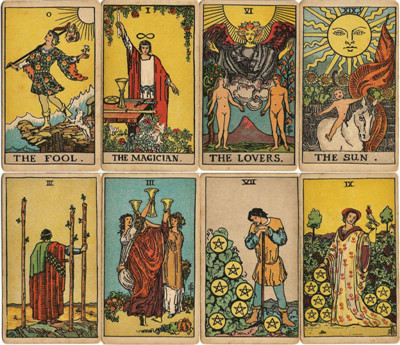
Contrary to what the uninitiated might think, the meaning of divination cards changes over time, shaped by each era's culture and the needs of individual users. This is partly why these decks can be so puzzling to outsiders, as most of them reference allegories or events familiar to people many centuries ago. Caitlín Matthews, who teaches courses on cartomancy, or divination with cards, says that before the 18th century, the imagery on these cards was accessible to a much broader population. But in contrast to these historic decks, Matthews finds most modern decks harder to engage with.
和外界所想的不一样,卡片上预言的意思随着时代变迁不断改变,在不同的文化或者不同的人手中也不尽相同,显示出不同的寓意和对现实事件的反映,这也是塔罗牌对于普通人来说不易理解的一个原因。Caitlín Matthews,一个教授纸牌占卜的老师,或者说算命师告诉我们,在十八世纪以前相信塔罗牌占卜的人数比现在多得多,而且和那些古老的塔罗占卜相比,现在的塔罗牌更加不容易理解。
"You either have these very shallow ones or these rampantly esoteric ones with so many signs and symbols on them you can barely make them out,"says Matthews. "I bought my first tarot pack, which was the Tarot de Marseille published by Grimaud in 1969, and I recently came right around back to it after not using it for a while." Presumably originating in the 17th century, the Tarot de Marseille is one of the most common types of tarot deck ever produced. Marseille decks were generally printed with woodblocks and later colored by hand using basic stencils.
“你会发现一副牌显示出如此多的信息,或强或弱,搞得你根本无法作出解读,”Matthews说。“我得到的第一副塔罗牌是1969年法国B.P.格利莫公司的马赛塔罗牌,我已经很长时间没有碰过它了,直到最近我又把它找了出来。”马赛塔罗牌起源于十七世纪,是最流行的塔罗牌之一,一般使用木版印刷,再用孔版上色。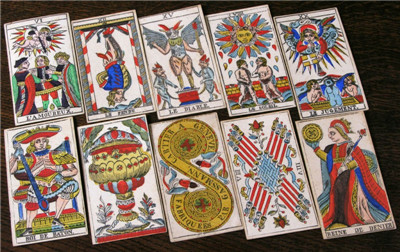
Top: A selection of trump cards (top row) and pip cards (bottom row) from the first edition of the Rider-Waite deck, circa 1909. Via the World of Playing Cards. Above: Cards from a Tarot de Marseille deck made by François Gassmann, circa 1870. Photo courtesy Bill Wolf.
上:几张1909年印制的初版伟特塔罗牌
下:1870年Fran?ois Gassmann印制的马赛塔罗牌
However, using cards for playful divination probably goes back even further, to the 14th century, likely originating with Mamluk game cards brought to Western Europe from Turkey. By the 1500s, the Italian aristocracy was enjoying a game known as "tarocchi appropriati," in which players were dealt random cards and used thematic associations with these cards to write poetic verses about one another—somewhat like the popular childhood game “MASH.” These predictive cards were referred to as "sortes," meaning destinies or lots.
然而用纸牌进行有趣占卜的历史大概更加久远,上溯至十四世纪,有很大可能性是由土耳其的马木留克骑兵传入欧洲。到了1500年代,意大利贵族中流行一种叫做“tarocchi appropriati”的游戏,人们选出随机的牌,对应上面的主题为别人写下诗句,有点像现在流行的儿童游戏“MASH”.这种卡牌预言的方式在拉丁语里被称作“sortes”,意思是命运或者抓阄。
Even the earliest known tarot decks weren't designed with mysticism in mind; they were actually meant for playing a game similar to modern-day bridge. Wealthy families in Italy commissioned expensive, artist-made decks known as “carte da trionfi” or “cards of triumph.” These cards were marked with suits of cups, swords, coins, and polo sticks (eventually changed to staves or wands), and courts consisting of a king and two male underlings. Tarot cards later incorporated queens, trumps (the wild cards unique to tarot), and the Fool to this system, for a complete deck that usually totaled 78 cards. Today, the suit cards are commonly called the Minor Arcana, while trump cards are known as the Major Arcana.
即使是最早形式的塔罗牌,也不是按照脑中产生的神秘喻示来设计的,它是一种和现代的桥牌更加类似的游戏。富有的意大利家庭使用昂贵的,名家制作的纸牌,称作“carte da trionfi”或者说“强手牌”。这些牌上面的标志是杯子,宝剑,钱币,马球棍(后来发展成权杖和魔杖),以及由一个国王和两个随从组成的法庭。接下来塔罗牌里又在这个系列里加上了皇后,王牌(塔罗牌中一张地位特殊的牌),和愚者,牌的总数发展到了78张。今天,副牌组被称作小阿卡那,而主牌组被称作大阿卡那。
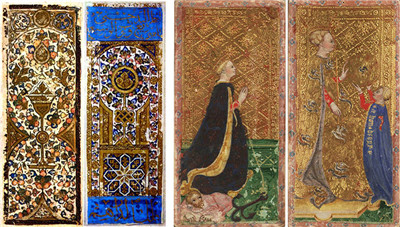
Two hand-painted Mamluk cards from Turkey (left) and two cards from the Visconti family deck (right), both circa 15th century.
在土耳其发现的两张手制的马木留克牌(左)和两张来自Visconti家族的纸牌(右),都制作于15世纪。
Graphic designer and artist Bill Wolf, whose interest in tarot illustration dates to his art-school days at Cooper Union in New York, has his own theories about the tarot's beginning. Wolf, who doesn't use cards for divination, believes that originally, “the meaning of the imagery was parallel to the mechanics of the play of the game. The random draw of the cards created a new, unique narrative each and every time the game was played, and the decisions players made influenced the unfolding of that narrative.” Imagine a choose-your-own-adventure style card game.
Bill Wolf是一名绘图师和艺术家,当年在纽约的库伯联盟学院攻读艺术学位时的兴趣就是研究塔罗牌插画的年代,对于塔罗牌的起源他有另一套理论。作为一个并不用塔罗牌进行占卜的人,他相信,“那些图画的意义恰好表现了它们在这个游戏中的玩法,每次随意画出的一张新牌,都会在游戏中被赋予新的意义,而古老的玩家对它们的使用又继续影响了这些意义的变化。”想象中那是一种随意决定玩法的卡牌游戏。
"The imagery was designed to reflect important aspects of the real world that the players lived in, and the prominent Christian symbolism in the cards is an obvious reflection of the Christian world in which they lived," he adds. As divinatory usage became more popular, illustrations evolved to reflect a specific designer's intention. "The subjects took on more and more esoteric meaning,"says Wolf, "but they generally maintained the traditional tarot structure of four suits of pip cards [similar to the numbered cards in a normal playing-card deck], corresponding court cards, and the additional trump cards, with a Fool."
“画里的寓意表现了当时人们所生活的年代中一些重要的方面,这其中明显的耶教符号正显示出当时社会强烈的宗教倾向。”他补充道。当它越来越流行被用来占卜后,图画中更表现出其设计者的倾向和喜好。“那些象征被赋予了越来越深奥的意义,”Wolf说,“但是大体上保持住了传统的塔罗牌结构,四套副牌(和现在带数字的扑克牌比较类似),相对应的角色牌,和传统的主牌组,加上一张小丑。”
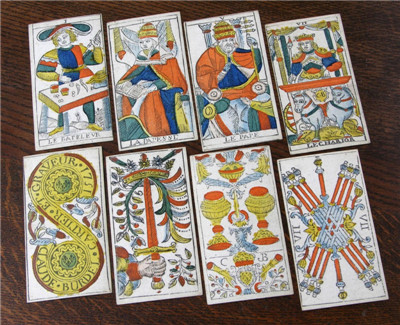
This woodblock version of the classic Tarot de Marseille was published around 1751 by Claude Burdel. Photo courtesy Bill Wolf.
1751年由Claude Burdel印制的木版传统马赛塔罗牌,由Bill Wolf摄影
Even if you aren't familiar with tarot-card reading, you've likely seen one of the common decks, like the famous Rider-Waite, which has been continually printed since 1909. Named for publisher William Rider and popular mystic A.E. Waite, who commissioned Pamela Colman Smith to illustrate the deck, the Rider-Waite helped bring about the rise of 20th-century occult tarot used by mystical readers.
即使你对解读塔罗牌并不熟悉,你也一定见过这些种类的牌,比如著名的伟特塔罗牌,从1909年起开始印制。以出版商Claude Burdel和知名神秘主义者A.E. Waite的名字命名,由著名画师,艺术家,作家Pamela Colman Smith设计图案,伟特牌带动了20世纪中塔罗牌在神秘主义爱好者中间的流行。
"The Rider-Waite deck was designed for divination and included a book written by Waite in which he explained much of the esoteric meaning behind the imagery,"says Wolf. “People say its revolutionary point of genius is that the pip cards are ‘illustrated,' meaning that Colman Smith incorporated the number of suit signs into little scenes, and when taken together, they tell a story in pictures. This strong narrative element gives readers something to latch onto, in that it is relatively intuitive to look at a combination of cards and derive your own story from them.
“伟特牌一开始就是被设计用来占卜的,并附带一本由Waite撰写的书,解释图画背后蕴含的意思,”Wolf说。“人们说他们带来的最大改变就是副牌组也有了插图,Colman Smith把原先上面的数字改成了小的图案,几张牌上的图案可以连成一段话,占卜者可以从里面牵强的意义里附会出什么东西,由此就可以按直觉把这些牌联系起来,从中得出一段预言。”
"The deck really took off in popularity when Stuart Kaplan obtained the publishing rights and developed an audience for it in the early '70s," says Wolf. Kaplan helped renew interest in card reading with his 1977 book, Tarot Cards for Fun and Fortune Telling, and has since written several volumes on tarot.
“直到1970年代初Stuart Kaplan得到了伟特牌的发行权,并把它推广,这副塔罗牌才真正变得流行起来,”Wolf说。Kaplan用他1977年推出的《有趣的塔罗牌,预知未来》重新唤起了人们的兴趣,并且之后发行了好几个版本的塔罗牌。
A version of the popular Rider-Waite deck from 1920. Photo courtesy Bill Wolf.
一种1920年流行的伟特牌
Though historians like Kaplan and Matthews publish new information on divination decks every year, there are still many holes in the larger story of fortune-telling cards. Wolf points out that those who use cards for divination are often at odds with academics researching their past. “There's a lot of friction between tarot historians and card readers about the origins and purpose of tarot cards,” Wolf says. “The evidence suggests they were invented for gaming and evolved for use in divination at a much later date. Personally, I believe they were designed for game play, but that the design is a bit more sophisticated than many tarot historians seem to believe.”
尽管像Kaplan和Matthews这样的历史学家们每年都在推出新书,描述卡牌占卜的历史,用卡片预知未来的历史仍然有很多未解的地方。Wolf指出,那些仍然用卡片占卜的人与研究者之间往往不能达成一致。“关于牌的起源和意义,研究塔罗牌的历史学家和占卜者之间经常发生摩擦,”Wolf说,“有证据表示纸牌被用于赌博和占卜是在比较晚的年代了,从个人来讲我觉得它的起源就是一种游戏,但是我觉得塔罗牌的设计应该比很多历史学家想的更复杂一些。”
By the mid-18th century, the mystical applications for cards had spread from Italy to other parts of Europe. In France, writer Antoine Court de Gébelin asserted that the tarot was based on a holy book written by Egyptian priests and brought to Europe by Gypsies from Africa. In reality, tarot cards predated the presence of Gypsies in Europe, who actually came from Asia rather than Africa. Regardless of its inaccuracies, Court de Gébelin's nine-volume history of the world was highly influential.
在十八世纪中期,卡牌的神秘用途从意大利传播到了欧洲的其他地方。在法国,作家Antoine Court de Gébelin坚持说塔罗牌源自一本古埃及祭司的圣书,并由吉普赛人从非洲带来。而事实上塔罗牌在欧洲的出现要早于吉普赛人,而吉普赛人实际上来自亚洲,而不是非洲。先不管这些错误,Court de Gébelin写的九卷本倒是广为传播。
Teacher and publisher Jean-Baptiste Alliette wrote his first book on the tarot in 1791, called “Etteilla, ou L'art de lire dans les cartes," meaning "Etteilla, or the Art of Reading Cards." (Alliette created this mystical pseudonym “Etteilla” simply by reversing his surname.) According to Etteilla's writings, he first learned divination with a deck of 32 cards designed for a game called Piquet, along with the addition of his special Etteilla card. This type of card is known as the significator and typically stands in for the individual having their fortune read.
教师和出版家Jean-Baptiste Alliette在1791年写了他的第一本关于塔罗牌的书,名为《Etteilla, ou L'art de lire dans les cartes》,意思是“艾特拉,卡片中蕴含的秘密”(Alliette发明了这个神秘学词汇“艾特拉”,就是把他的姓的拼写颠倒过来)。在他对“艾特拉”的描述里,他一开始是从一种叫做“皮克牌”的32张纸牌的游戏中学会占卜术的,里面再加上他特别的“艾特拉”牌,就被视为一种典型而知名的用于个人占卜的卡牌。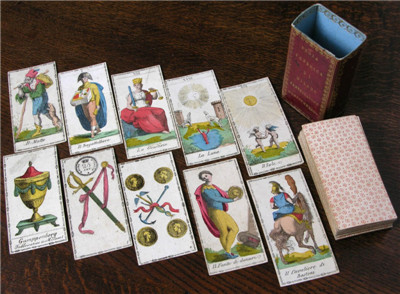
A hand-colored set of tarot cards produced by F. Gumppenberg, circa 1810. Photo courtesy Bill Wolf.
1810年由F. Gumppenberg制造的一种手绘塔罗牌。
While the tarot is the most widely known, it's just one type of deck used for divination; others include common playing cards and so-called oracle decks, a term encompassing all the other fortune-telling decks distinct from the traditional tarot. Etteilla eventually switched to using a traditional tarot deck, which he claimed held secret wisdom passed down from ancient Egypt. Etteilla's premise echoed the writings of Court de Gébelin, who allegedly recognized Egyptian symbols in tarot-card illustrations. Though hieroglyphics had not yet been deciphered (the Rosetta Stone was rediscovered in 1799), many European intellectuals in the late 18th century believed the religion and writings of ancient Egypt held major insights into human existence. By linking tarot imagery to Egyptian mysticism, they gave the cards greater credibility.
当塔罗牌已经广为人知之后,它仍然不是唯一一种用于占卜的纸牌;其他的包括普通的扑克牌和一种叫做神谕卡的卡牌,那是一种综合了其他所有占卜牌的特点而又和传统塔罗牌截然不同的卡牌。“艾特拉”后来又发展成了现在所讲的,其中蕴含着古埃及智慧的塔罗牌,Court de Gébelin从“艾特拉”中获取了灵感,据说他从塔罗牌的插画中辨认出了古老的埃及符号。虽然古埃及的象形文字直到现在都没有被完全破译(罗塞塔石碑在1799年才被发现),早在十八世纪晚期就有很多人相信古埃及的宗教和文化深远地影响到了人类存续,通过把塔罗牌上的图像和神秘的古埃及联系起来,他们给塔罗牌赋予了更多的意义。
Building on Court de Gébelin's Egyptian connection, Etteilla claimed that tarot cards originated with the legendary Book of Thoth, which supposedly belonged to the Egyptian god of wisdom. According to Etteilla, the book was engraved by Thoth's priests into gold plates, providing the imagery for the first tarot deck. Drawing on these theories, Etteilla published his own deck in 1789—one of the first designed explicitly as a divination tool and eventually referred to as the Egyptian tarot.
在Court de Gébelin把塔罗牌和古埃及联系起来之后,Alliette宣称塔罗牌的起源来自代表古埃及智慧之神透特的圣书。据他所说,圣书被透特的祭司刻在黄金的薄片上,最初的塔罗牌图案就来源于此。根据这些理论,Alliette在1789年出版了他的第一种明确用于占卜的牌,之后被称作埃及塔罗牌。
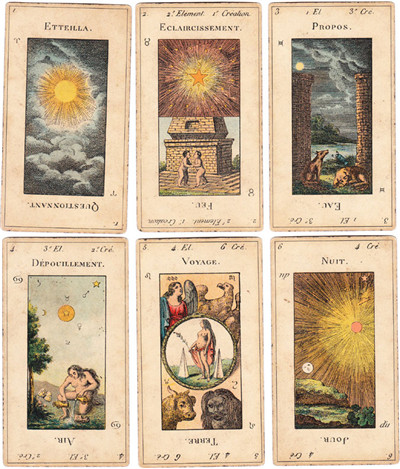
A few of the cards from Etteilla's esoteric deck, reproduced by Grimaud in 1890.
1890年,Alliette的塔罗牌组。
"Etteilla was one of the people who actually made divination so esoteric," says Matthews. “He created a deck that incorporated all the things from Court de Gébelin and his book ‘Le Monde Primitif' ['The Primitive World'], which suggested an Egyptian origin for the tarot and all sorts of arcane things."Matthews makes a distinction between the tarot's abstract interpretations and the straightforward 'cartomantic'reading style that thrived during the 16th and 17th centuries, prior to Etteilla.
“像Alliette这样的人将占卜变得更加神秘化,”Matthews说,“他的牌里吸收了Court de Gébelin的书《Le Monde Primitif(世界始源)》里所有的内容,包括塔罗牌起源于埃及和其他神秘的东西。”Matthews对于十六到十七世纪时早于“艾特拉”的塔罗牌占卜中“抽象解读”和“直接解读”这两种方法进行了区分。
"When we used to send telegrams, each word costs money,"Matthews explains, "so you'd have to send very few words like, ‘Big baby. Mother well. Come to hospital.' And you'd get the gist of it. I read cards in a very similar way—starting from a few general keywords and making sense of them by filling in the words that are missing. This isn't the tarot style of reading where you project things, like, 'I can see that you've recently had a great disappointment. Mercury is in retrograde and da da da.' A cartomantic reading is much more straightforward and pragmatic, for example, ‘Your wife will eat tomatoes and fall off the roof and die horribly.' It's a direct way of reading, a pre-New Age way of reading."
“我们以前发电报时,每一个单独的字都是要花钱的,”Matthews解释,“所以你说的话得尽量短比如,‘母将到院,亲',从这几个字里你就可以找到要点。我的塔罗牌解读方法是很简单的,找到几个关键字,再把中间缺少的部分补上组成一个完整的句子。这和那种需要察言观色的占卜术不同,比如‘我发现你今天很沮丧,你的水星轨道正在倒退'之类。相比之下我的方法更加直接和实用,得到的结果会是‘你妻子将会在吃番茄后从屋顶掉下死掉'这样直接的解读,这是新世纪的占卜形式。”
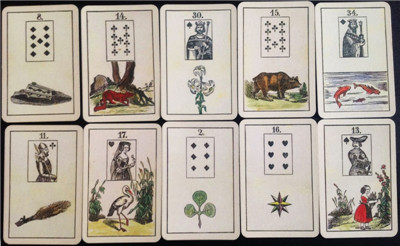
One of Matthews'favorite decks is the Lenormand published by Bernd A. Mertz in 2004 based on a design circa 1840. Photo courtesy Caitlín Matthews.
Matthews最喜欢的一套牌,由Bernd A. Mertz在2004年印制,基于1840年的版本。
Matthews has authored several books on divinatory cards, and her latest, The Complete Lenormand Oracle Cards Handbook, will be published in October of this year. This 36-card deck was named after the celebrity card-reader Mademoiselle Marie Anne Lenormand, who was popular around the turn of the 18th and 19th centuries, though the decks bearing her name weren't actually produced until after her death. The oldest packs in Matthews' collection are two Lenormand-style decks, the French Daveluy of the 1860s and the Viennese Zauberkarten deck from 1864, which were some of the first decks to be illustrated using the technique of chromolithography.
Matthews已经发行了好几本关于卡牌占卜的书,而他最新的一本《莱诺门奥秘牌完全手册》即将在今年十月出版。这种由三十六张牌组成的占卜牌是以著名的占卜家Mademoiselle Marie Anne Lenormand的名字命名的,而她活跃在十八到十九世纪之交,虽然直到她死后这种牌仍然没有被发明出来。Matthews手中最古老的收藏品就是两副莱诺门牌,分别出自1860年代法国的Daveluy和1864年维也纳的Zauberkarten之手,都是第一代用石版彩印技术印制的牌。
Oracle decks like the Lenormand tend to rely on more direct visual language than traditional tarot cards. "The tarot can often speak in broad, timeless, universal statements about our place in the world," says Wolf. "The imagery of fortune-telling decks is more illustrational and less archetypal. The images are generally more specific, simpler, and less universal, keeping the conversation more straightforward."
像莱诺门牌这样的奥秘牌相对于传统的塔罗牌来说可以表达出更多的视觉信息。“塔罗牌表现出了我们所存在的宇宙的永恒和广阔。”Wolf说。“占卜牌上的图像是具体而超前的,大体上它们都简洁而蕴含着指向性的信息,让灵性的对话更加直接。”
In contrast to most oracle decks, which don't include suited pip cards, Lenormand cards feature a unique combination of numbered playing-card imagery on top of illustrated scenes used for fortune-telling. "One of the earliest versions, called the Game of Hope, was made by a German named J.K. Hechtel and was prepared like a board game," says Matthews. "You laid out cards 1 to 36, and the object of the game was to throw the dice and move your tokens along it. If you got to card 35, which was the anchor card, then you're home, safe and dry. But if you went beyond that, it was the cross, which was not so good. It was like the game Snakes and Ladders." In this way, the Game of Hope fell into the Victorian-era tradition of board games that determined a player's life story based on luck.
和大部分奥秘牌不同,莱诺门牌独特地含有副牌组,在它的有编号的每一张牌上都有用于预测未来的小图。“它最初的版本是一种由德国人J.K. Hechtel发明的叫做‘希望游戏'的桌游。”Matthews说。“在桌子上摆开标着1到36的牌,游戏的玩法就是你扔出一个骰子,按照上面的数字把棋子沿着数字移动,如果下到了35号的位置,就是所谓的‘锚地',你就算回到老家了,干燥又温暖;如果你越过了锚地,就到了‘十字路口',那可不是什么好消息,它很像蛇梯棋。”这种希望游戏在维多利亚时代发展成了一种预测玩家未来命运的桌游。
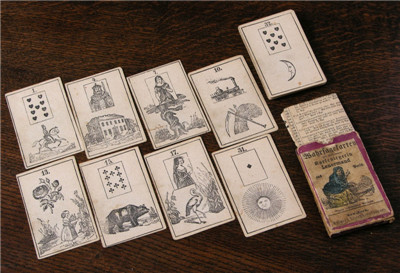
This Lenormand-style oracle deck shows a mixture of playing card and fortune-telling illustrations, circa 1870. Photo courtesy Bill Wolf.
莱诺门式的奥秘牌混合了各种卡牌游戏和占卜的风格。
The game's original instructions said it could be used for divining because the illustration on each card included both a symbolic image, like the anchor, and a specific playing card, like the nine of spades. "Hechtel must have seen that there were overlaps between divining with playing cards, which, of course, everyone did, and his game," says Matthews. "Many other oracle decks appeared around the same time at the end of the 18th century and into the early 19th century. They became really popular after the Napoleonic Wars when everyone settled down and became terribly bourgeois.
最初这种游戏的玩法就显示出它可以被用作占卜,因为每一张牌上都画有比如像锚这样有象征意义的图案,或者其本身就有特殊寓意,如黑桃五。“德国人Hechtel肯定预见了他的纸牌游戏和占卜之间会产生联系,当然,很多那时候的人也就是那样做的,”Matthews说。“在十八世纪晚期到十九世纪刚开始之间产生了很多种神谕牌,它们之所以变得流行是因为与拿破仑之间发生的战争结束了,社会变得安定下来,资本主义蓬勃发展。”
"Quite recently, it was discovered by Mary Greer that there was a prior source to the Lenormand cards," she continues. “There's a deck in the British Museum called ‘Les Amusements des Allemands' (‘The German Entertainment'). Basically, a British firm put together a pack of cards that has images and little epigrams on the bottom, which say things like, ‘Be aware, don't spend your money unwisely,' and that sort of thing. It's quite trite. But it came with a book of text that's almost identical to the instructions for later packs of Lenormand cards."
“到了近代,才由Mary Greer发现还有一种比莱诺门牌更早的形式,”她继续道。“现在在大英博物馆中还收藏着一副被称作‘Les Amusements des Allemands(德国人的把戏)'的牌。”基本上它就是由一个英国公司发明的,在一副有插图的牌背面都加上一个警句,比如‘谨慎运用你的钱财'之类。说句实话它非常的老套,但是附带的一本使用说明却代表了后来莱诺门牌的发展方向。”
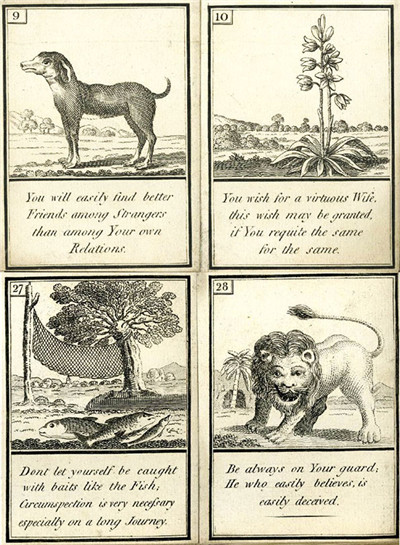
"Les Amusements des Allemands," circa 1796, has many overlaps with Lenormand decks. Via the British Museum.
“Les Amusements des Allemands,”和莱诺门牌有很多相似之处,藏于大英博物馆。
By comparing various decks from different time periods, tarot-card enthusiasts can identify the evolution of certain illustrations. "For example," says Matthews, "the modern version of the hermit with the lantern, you'll find that that was an hourglass and he was Saturn or Chronos, the keeper of time. You can see how that translates with the Tarot Bolognese meaning of delay or blockage. It was about time moving slowly, though that's not used as a modern meaning much now."
通过对不同时代的牌的比较,塔罗牌爱好者们可以总结出上面插图的进化史。“比如,”Matthews说,“你会发现现代版本中提着灯笼的隐士旁边有一个沙漏,他代表着罗马神话中的萨图恩或者说希腊神话中的克洛诺斯,时间之神。这张牌在古代意大利波隆那版本中只是拖延或者停顿的意思,和它的现代版本差异很大。”
Most card readers recognize that the associations and preconceptions of the person being read for are just as important as the actual drawings on the cards: Divination cards offer a way to project certain ideas, whether subconscious or not, and to toy with potential outcomes for important decisions. Thus, like scenes from a picture book, the best illustrations typically offer clear visions of their subjects with an open-ended quality, as though the action is unfolding before you.
相对于卡牌上的图案所显示的东西,很多占卜者在给别人占卜时也利用对对方的观察和推测,占卜牌提供了一种可能是在潜意识中表达具体意见的方式,可以对重要的决定产生潜在的影响。尽管根据塔罗书上讲的那样有无数种组合,牌面上插图只能明显的提供一个物象,其解读是完全开放式的。
Matthews' favorite decks are those with straightforward illustrations, like the Tarocchino Bolognese by Giuseppe Maria Mitelli, an Italian deck created sometime around the 1660s. Matthews' owns a facsimile of the Mitelli deck, rather than an original, which means she can use them without fear of damaging a priceless antique. “The deck that I enjoy most is the Mertz Lenormand deck because of its clarity,” she says. “The background on each card is a creamy, vellum color, so when you lay them out in tableau, you can see the illustrations very clearly. I frankly get so tired of all the new Photoshopped tarots and the slick art, with their complete lack of any framework or substance.
Matthews最喜爱的牌组就是有喻意很直接的插图的,比如1660年左右意大利人 Giuseppe Maria Mitelli发明的波隆那塔罗牌,Matthews收藏了一副这个价值连城的古董的收藏品。“还有一副我最喜欢的牌是梅茨的莱诺门牌,因为它看起来清楚,”她说。“每一张的背景都是奶油色的,牛皮纸一样的单色,所以你能清楚地看出上面的图案。我已经受够了现在那些新式的修图过度,有无数渐变色,但是实在表达不出更多含义的牌。”
Trump cards from the Tarrocchini Bolognese designed by Giuseppe Maria Mitelli, circa 1664.
1664年,Giuseppe Maria Mitelli的波隆那塔罗牌。
"I also enjoy reading with the Lenormand deck made by Daveluy, which has been beautifully reworked by Lauren Forestell, who specializes in restoring facsimile decks—cleaning up 200 years' worth of card shuffling and human grief. The coloring on the Daveluy is very beautiful. Chromolithography gave an incredibly clear color to everything, and I think it was probably as revolutionary as Technicolor was in the days of the movies."
“我同样喜欢Daveluy制作的莱诺门牌,Lauren Forestell现在把它重制过了,他是一个复制过上下近200年历史的塔罗牌的专家,Daveluy的牌色彩艳丽,石版印刷术让每一种颜色都显得分明,我认为这种技术革新的意义等同于彩色电影的发明。”
The illustration on some decks did double duty, providing divinatory tools and scientific knowledge, like the Geografia Tarocchi deck from around 1725. "The Geografia are extraordinary cards, almost like a little encyclopedia of the world with the oracle imagery peeking out at the top," Matthews says. "The actual bit that you read from is just a cigarette-card length. So for example, the hanged man just shows his legs at the top of the card, while the rest of the card has information about Africa or Asia or other places on it."
插图不仅有占卜学上的意义,有些时候它也传播了科学,比如在约1725年出现的地理塔罗牌。“地理塔罗牌是很特别的,几乎就是一部小的百科全书,同时上面又印着占卜用的图案,”Matthews说。“虽然你能读到的部分只有烟盒一样大小,举个例子,倒吊人这张牌的上面只有他的腿,剩下的部分写着关于非洲和亚洲的内容。”
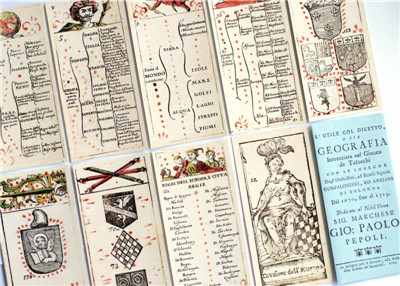
On the Geografia deck, the symbolic imagery is reduced to a small colored segment at the top of each card; the rest is related to global geography. Via eBay.
eBay上的地理塔罗牌,占卜图像只占很小一部分,剩下的都是全球地理知识。
In contrast, the meanings in other decks are particularly difficult to decipher, like the infamous Thoth tarot developed by Aleister Crowley, notorious for his involvement with various cults and experimentation with recreational drugs and so-called “sex magick." Completed in 1943, the Thoth deck was illustrated by Lady Frieda Harris and incorporated a range of occult and scientific symbols, inspiring many modern decks. As Wolf explains, "with the rise of the divination market in the 20th century, more liberties were taken, and the imagery evolved into increasingly personal artistic statements, both in content and style of execution."
与这些知识相比,塔罗牌上的其他意思是很难解读的,比如说1943年Aleister Crowley发明的著名的透特塔罗牌,就像综合了各种宗教祭仪和嗑药后的效果,被称作“性感魔法”,它的插图来自Frieda Harris女士,使用了一些神秘学和自然科学中的符号,它影响了后世的塔罗牌的风格。Wolf对此这样解释:“二十世纪占卜学兴起之后,其风格越来越自由化,那些图案本身的风格和对其的解读都带上了更强的个人风格。”
But to balance such arcane decks, there are divinatory cards that offer little room for interpretation, like “Le Scarabée d'Or"or The Golden Beetle Oracle, one of Wolf's most prized decks. "It's just fantastically bizarre. There's a little window in the lid of the card box, and when you shake it, the beetle appears, and points to a number,” he explains. "Then you find the corresponding number on a set of round cards, with beautiful script text on them, and read your fortune. Can you not imagine standing in a Victorian parlor in France, consulting the Golden Beetle? It was like performance art."
卡牌占卜越发神秘化之后,又出现了一些提供较少想象空间的占卜牌,比如“Le Scarabée d'Or”或者Wolf最喜欢的“金龟子牌”。“它独特而有趣,牌盒上有一个小小的洞,你摇动它就会出现一只甲虫,指向一个数字。”他解释。“然后你在一堆牌中找出这个数字,上面写着一段揭示你未来的隽永的句子。想象一下维多利亚时代的你坐在法国的客厅里向金甲虫问卦的场景,那是一种艺术。”
The Art of Divination Cards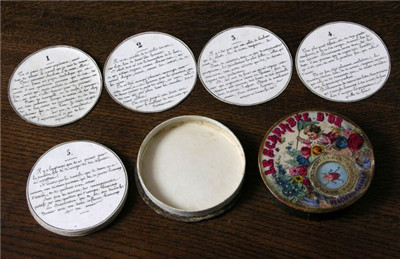
The Golden Beetle deck, circa 1860. Photo courtesy Bill Wolf.
1860年的金龟子牌]
The magic oracle box for the Golden Beetle deck. Photo courtesy Bill Wolf.
盛放金龟子牌的魔法盒子
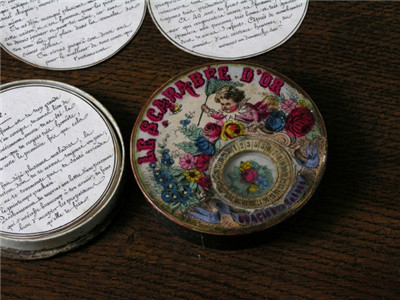
Aces for the four suits in the Mitelli tarot deck, with engravings, circa 1664.
意大利那啥牌的AKQJ
Hannell's fortune-telling deck incorporated typical playing card suits along with its particular illustrations, circa 1808. Photo courtesy Bill Wolf.
1808年Hannell的预测未来纸牌,有现代纸牌的风格和特别的图案。
This cartomancy deck from Austria included four language translation—German, Italian, French, and English—and shows signs of significant use, circa 1820. Photo courtesy Bill Wolf.
翻译成四种语言的奥地利占卜牌,其德语,意大利语,法语和英语版本。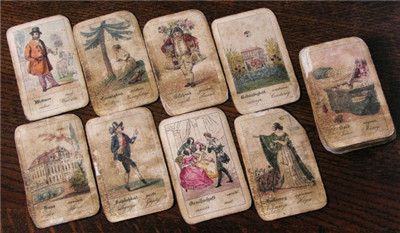
This vibrant deck of Marseille style tarot cards was published by François Gassmann, circa 1870. Photo courtesy Bill Wolf.
1870年,François Gassmann的马赛牌。

This Lombardy style tarot deck was woodblock printed by Pietro Oletti, circa 1870. Photo courtesy Bill Wolf.
1870年Pietro Oletti木版印刷的伦巴第风格塔罗牌。
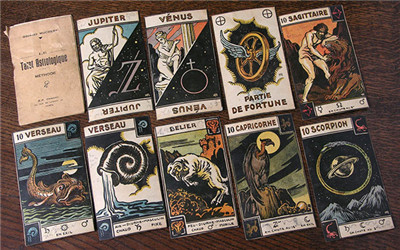
Eventually, artists incorporated all manner of mystical symbols to tarot illustrations, like this Tarot Astrologique designed by Georges Muchery, circa 1890. Photo courtesy Bill Wolf.
后来艺术家们总结出了所有塔罗牌上的神秘符号,比如Georges Muchery设计的这一副。
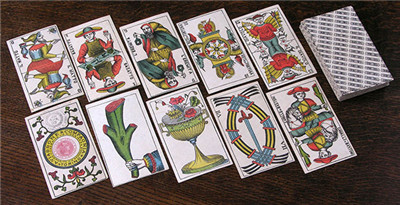
This double-ended Piedmont tarot was printed by Alessandro Viassone, circa 1893. Photo courtesy Bill Wolf.
1893年Alessandro Viassone的双面塔罗牌。
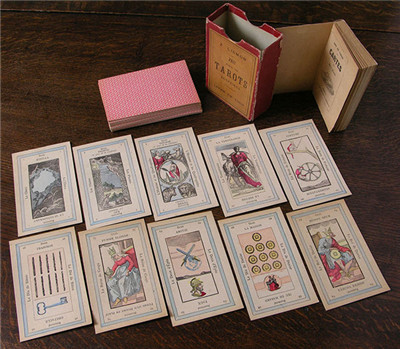
This woodblock Etteilla deck printed by Z. Lismon, circa 1880, includes several layers of esoteric meaning. Photo courtesy Bill Wolf.
1880年Z. Lismon的木版艾特拉牌,不同的框里写着神秘的词。

The Green Spade Pow Wow Tarok made by A. Petryl & Sons in 1922 featured Native American imagery. Photo courtesy Bill Wolf.
A. Petryl & Sons公司在1922年印第安人风格的塔罗牌。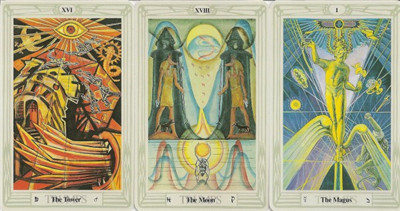
Though finished in 1943, Aleister Crowley's highly esoteric Thoth tarot deck wasn't actually published until 1969.
1943年由Aleister Crowley设计,但在1969年才出品的极其神秘的塔罗牌。


